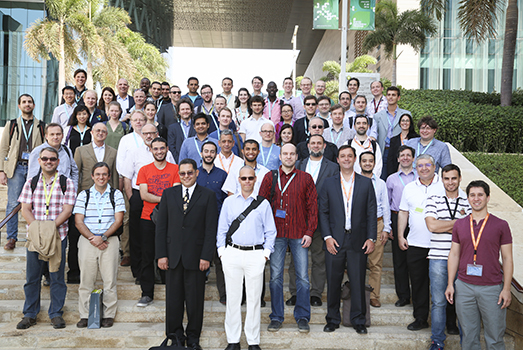Advances in uncertainty quantification methods

KAUST hosted the Advances in Uncertainty Quantification Methods, Algorithms and Applications conference (UQAW2016) from January 5-10, 2016. The conference was organized by the University's SRI Center for Uncertainty Quantification in Computational Science and Engineering, directed by Professor of Applied Mathematics and Computational Science Raul Tempone.
2016 marks the fourth consecutive year KAUST held the UQAW annual event, which is dedicated to reporting on state-of-the-art and latest advances in the methods used to quantify calculation uncertainties. The aim of the discussion forum is to exchange information on innovative algorithm design and practical applications and their performance in experimental settings.
The conference is an excellent opportunity for experts to meet and collaborate and for students starting their careers in science to get involved in top-notch research and network with prominent international researchers in statistics.
This year, 75 oral and poster presentations were featured at the event, and the conference hosted 20 invited speakers from countries including the United States, Germany, Canada, France, Greece and the U.K.
Professor Tempone also presented his latest research on computational approaches to fouling accumulation and wear degradation based on stochastic differential equations.
Fighting fouling at play
In simple terms, industrial processes with fouled pipes consume more energy. From a business standpoint, the motivation to predict and eventually mitigate fouling accumulation is quite clear. Current maintenance operations are based on the assumption that the fouling accumulation is deterministic over time and space, when, in reality, fouling deposition takes place randomly, making the resulting anti-accretion measures less cost-effective.
Fouling deposition is a pervasive process that affects all real pipework and induces a progressive loss of the system’s operative efficiency. Overlapping layers of fouling in heat exchangers and in cooling water systems of oil refineries, for example, are responsible for the increased resistance to heat transfer and for the consequent reduction of performance of the energy generation system. With this in mind, a reliable model of fouling accumulation has been clearly necessary to optimize maintenance operations and reduce engine shut-down periods.
Devising an effective model
Professor of Applied Mathematics and Computational Science Raul Tempone and his team at the Uncertainty Quantification in Computational Science and Engineering Center at KAUST took on this problem. They devised an innovative computational approach based on stochastic differential equations to predict the fouling patterns of heat exchangers.
The group developed a stochastic model that dramatically improves maintenance costs as well as time management. The probability distribution developed by Tempone’s group realistically described the accumulation of the twin-track source of fouling—organic and inorganic—and produced a model of the phenomenon dynamics able to realistically describe fouling accumulation.
Putting the model to work
A practical related application that challenged Tempone’s group was whether their stochastic model would help in predicting wear-degradation levels of cylinder liners in cargo ships. Today, preventive maintenance of large vessels is carried out mainly to avoid insurance claim rejections in case of mechanical failures.
With cylinder liners aging, the frequency of controls progressively increases, decreasing the ratio of the insurance cost over costs of ship maintenance. In a manner similar to fouling accumulation, cylinder liner degradation is a random process that needs stochastic modeling. Tempone and his collaborators were able to produce a probabilistic description of the evolution of the wearing and identified cost-effective maintenance levels.

